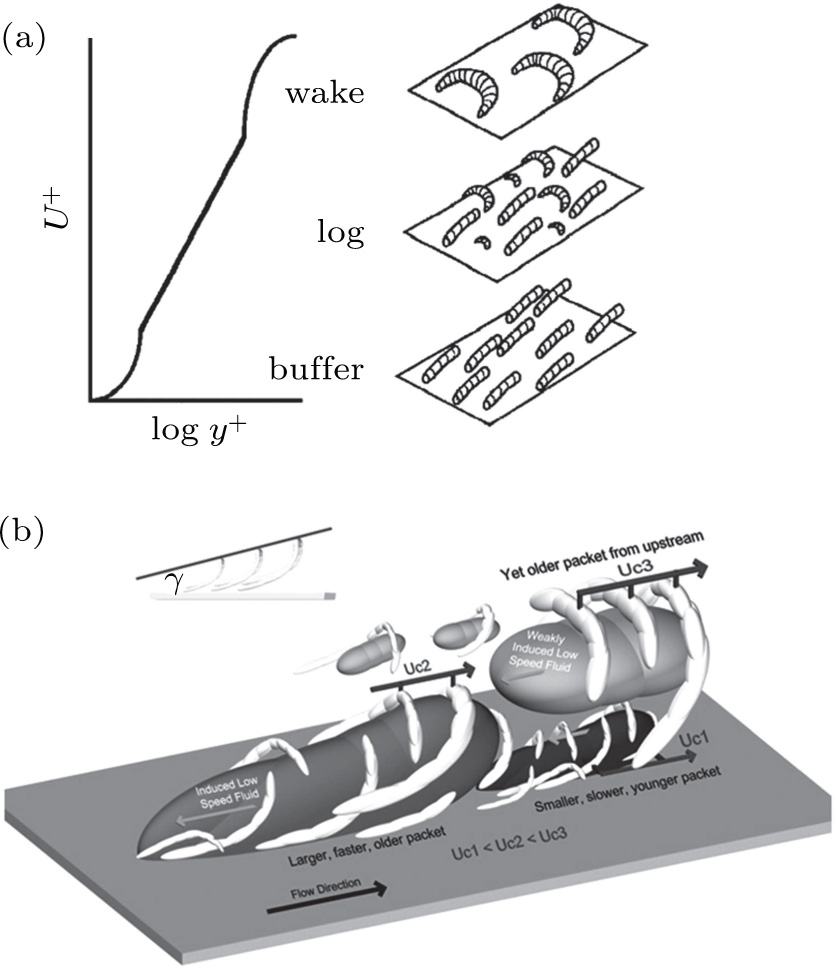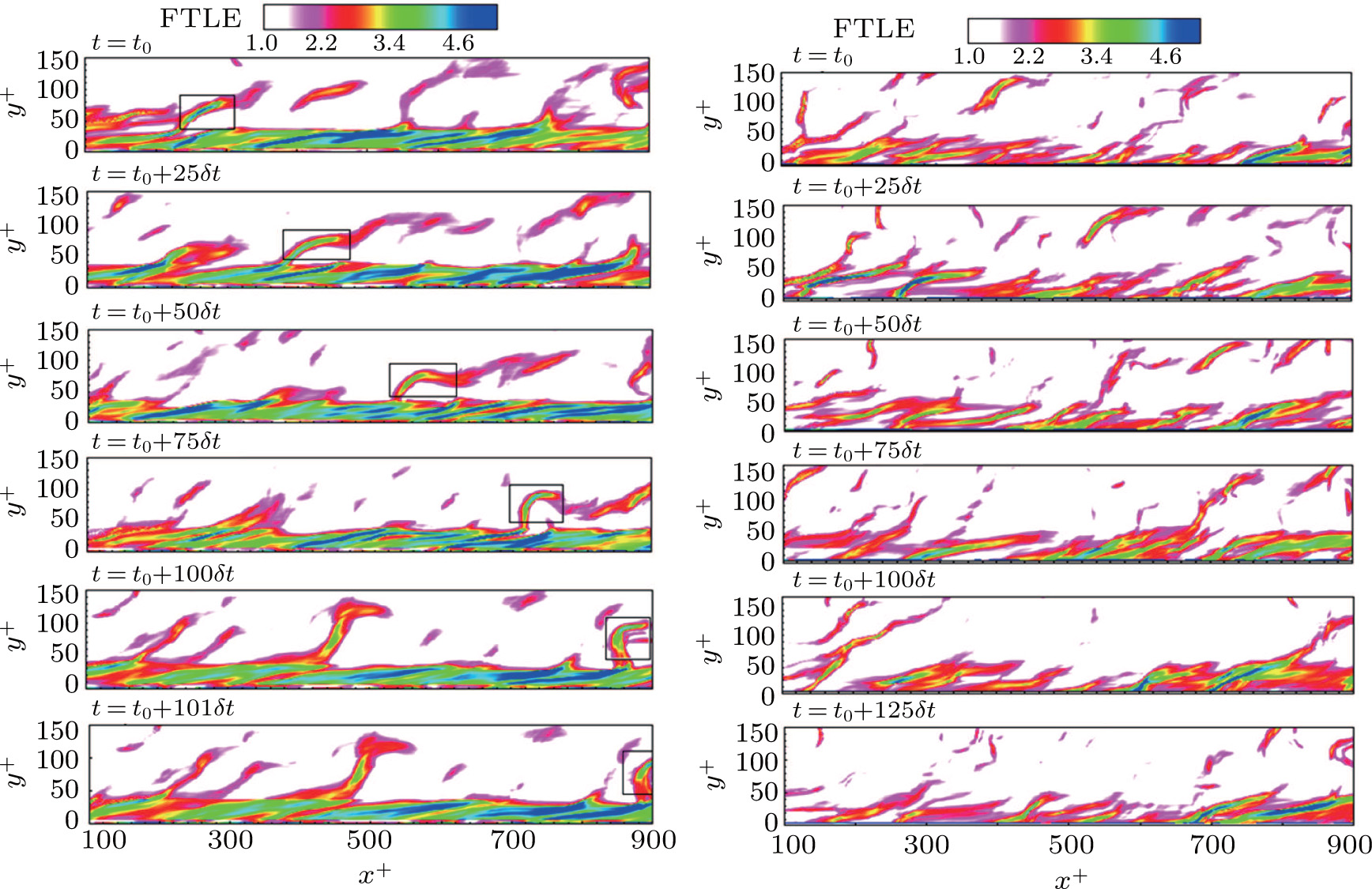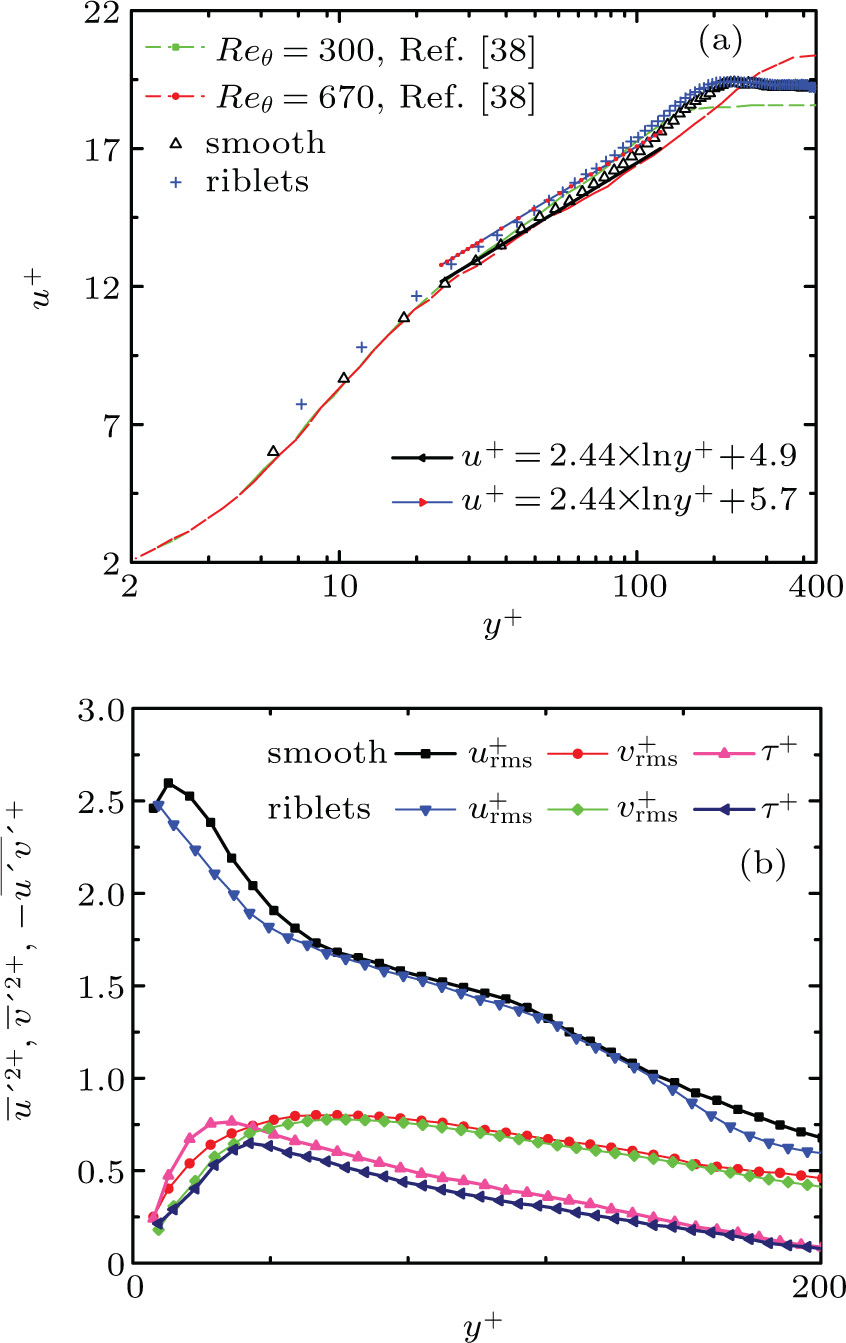† Corresponding author. E-mail:
Project supported by the National Natural Science Foundation of China (Grant Nos. 11332006, 11732010, 11572221, and 11502066) and the Natural Science Foundation of Tianjin City (Grant No. 18JCQNJC5100).
Time-resolved particle image velocimetry (TRPIV) experiments are performed to investigate the coherent structure’s performance of riblets in a turbulent boundary layer (TBL) at a friction Reynolds number of 185. To visualize the energetic large-scale coherent structures (CSs) over a smooth surface and riblets, the proper orthogonal decomposition (POD) and finite-time Lyapunov exponent (FTLE) are used to identify the CSs in the TBL. Spatial-temporal correlation is implemented to obtain the characters and transport properties of typical CSs in the FTLE fields. The results demonstrate that the generic flow structures, such as hairpin-like vortices, are also observed in the boundary layer flow over the riblets, consistent with its smooth counterpart. Low-order POD modes are more sensitive to the riblets in comparison with the high-order ones, and the wall-normal movement of the most energy-containing structures are suppressed over riblets. The spatial correlation analysis of the FTLE fields indicates that the evolution process of the hairpin vortex over riblets are inhibited. An apparent decrease of the convection velocity over riblets is noted, which is believed to reduce the ejection/sweep motions associated with high shear stress from the viscous sublayer. These reductions exhibit inhibition of momentum transfer among the structures near the wall in the TBL flows.
Nature is full of examples of structures, materials, and surfaces that can offer the inspiration for possible commercial applications. During a period of four billion years evolution, different kinds of creatures in nature are gradually exhibiting their functional biological surfaces.[1] By investigating and understanding the mechanisms of their features, we may be able to reproduce these biological phenomena on demand.[2] For example, the super-hydrophobic and self-cleaning character on the surfaces of a lotus leaf or rice leaves demonstrates a remarkable effect on drag reduction;[3] birds have developed streamlined shapes to improve their flying performance;[1] and the scales covered on the shark skin inspire us potential ways to reduce the drag in fluid flows. However, among all of the inspirations that nature provides us, including active and passive controls to the turbulent flow,[4–7] shark-skin-inspired riblets are one of the few techniques that have been successfully used both in the laboratory and in the engineering application, to reduce the skin friction in TBLs.[8] In the 1984 Olympic rowing events, the riblets were used to raise the speed; in the 1987 and 2010 American’s Cup sailing competitions, the hulls of the USA challengers were fitted with riblets. Both challengers succeeded, although there is no proof whether riblets have any real role (so far).[9]
Early studies have been able to confirm about 6%–7% drag reduction,[10,11] up to 9.9% was achieved lately.[9,12,13] Several classes of riblets with easily manufactured shapes have been investigated by numerous researchers, including triangular, trapezoidal, rectangular, and circular-segment, and the studies of drag-reduction, as well as heat transfer, were conducted.[14] Previous results showed that the best drag reduction performance was achieved with longitudinal blade riblets when they were aligned in the flow direction.[10,15]
Vortical structures have gained much attention recently, because they are identified to play a predominant role in the spatial organization and energy exchanges, thus providing us different means to control them. Since initially proposed by Theodorsen,[16] the importance of hairpin or horseshoe-type vortices in the wall-bounded turbulent flows has become widely accepted. In the past few decades, numerous experimental and numerical studies on CSs in the TBL have also been carried out.[17,18] Robinson summarised the structures he commonly observed in direct numerical simulations: in the region very close to the wall, quasi-streamwise vortices are dominant structures; while in the wake region, arches or horseshoe vortices occur frequently, as well as a mixture of these two kinds of structures in the logarithmic layer (see Fig.
 | Fig. 1. (a) Robinson’s summary of structures found in the direct numerical simulation of wall turbulence;[18] (b) Hairpin-packet paradigm by Adrian et al.[19] |
Several identification methods have been proposed to qualitatively describe the characterization of the coherent structures, including the wavelet transform,[22–24] linear stochastic estimation (LSE),[25] conditional sampling,[26] and other techniques like the quadrant splitting methods[27] and IQSM.[28] All of these are conditional techniques, encountering the same problem of the dependence on a conditional criterion. Therefore, the proper orthogonal decomposition (POD) method as first introduced to study turbulence by Lumley,[29] and finite-time Lyapunov exponent (FTLE) presented by Haller[30,31] appear as the most promising alternatives. The POD is the first rigorous theoretical and mathematically unbiased approach for extracting CSs from the turbulent flows, and FTLE is based on the trajectory of the particles; both methods avoid the subjective threshold selection of the Eulerian criterion.
The particle image velocimetry (PIV) technique can, nowadays, measure the instantaneous velocity vector fields in a specific plane or volume of the flows, returning many outstanding results based on instantaneous and statistical structural analysis in the turbulent flows.[21,32–34] This study is thereby motivated to investigate the drag reduction mechanism of riblets in detail using a time-resolved PIV (TRPIV) measurement system. In this paper, POD and FTLE methods are used to describe the topologies, spatial correlation, and convection velocity of the CSs in the TBLs at a friction Reynolds number Reτ = 185. Several interesting results are found from the application of FTLE to identify the coherent structures over smooth and riblets surfaces, and the mechanisms of the drag-reduction over riblets are studied from a different angle.
The present experiment is conducted in the recirculation-type water tunnel with a cross section of 0.15 m × 0.14 m × 1.3 m (height × width × length) at Tianjin University; a TBL flow is developed along a horizontally mounted flat acrylic plate at the free-stream velocity Ue of 0.19 m/s. Two 1200-mm-long plates are prepared and used in the test, one at each time. The leading edge is elliptic. One plate is with smooth surface, while the other one is fabricated with continuous saw-tooth riblets on its tail parts, with the crests on the same plane with the upstream smooth wall. A spanwise zigzag band is placed 150-mm downstream of the leading edge to trigger the flow to a fully developed TBL. The physical peak-to-peak spacing of riblets, s, is 1.4 mm (see Fig.
The working fluid is seeded with polyamide particles with a mean diameter of dp ≈ 10 μm and a density of 1.05 g⋅mm−3. A schematic of the experimental facility is illustrated in Fig.
During the experiment, three sets of six thousand statistically independent snapshots for the planar velocity fields in a region of 101 mm× 81 mm (streamwise× wall-normal, x–y) have been acquired with a sampling frequency of 250 Hz. The analysis process of the raw images is as follows: (i) firstly, the subtraction technique is applied to remove the background noise, eliminated the reflection of the light from the test plates; (ii) then, an interrogation window of 32 × 32 pixels with a 75% overlap rate is used for correlation calculation; and (iii) at last, range validation and average filter techniques are used to remove the noise from manufactured velocity fields. This whole process is performed with the Dantec Dynamics software. The velocity field has a spatial resolution of 0.643 mm in both x- and y- directions (∼ 6.7 viscous lengths, δν). The velocity measurement uncertainty of the whole system is estimated to be less than 1%.[26,35,36]
Definition of the virtual origin at that wall-normal position is necessary for the comparison of results over riblets. Choi et al.[37] defined it as the wall-normal location of an imaginary smooth surface which has the same friction drag as the riblets and matches the riblets velocity profile above its viscous sub-layer. The location herein is taken to be 0.18 s lower than the riblets tip in y-direction.[10,15]
The basic parameters of the experimental flow are given in Table 
| Table 1. Basic parameters and results. . |
As shown in Fig.
Lumley[29] pioneered the use of POD to extract the structures in turbulent flows. This method utilizes a linear operation of temporal coefficients and spatial eigenfunctions to characterize complex unsteady flows. Since its basic functions are dependent on the flow field,[45] it is more physical than conditional-averaged vortex criterions mentioned above. In POD, the fluctuation velocity u′(



The POD can extract a complete set of orthogonal modes by maximizing the energy of modes, and it also gives the eigenvalues which correspond to the kinetic energy of each mode, thereby it has been widely used in various turbulent flows to extract the energy-containing structures and events.[47,48] There are 1000 instantaneous fluctuation velocity fields used in this paper for POD analysis to reveal the coherent structures over the test plates.
 | Fig. 4. POD energy distribution: (a) fractional contribution of each POD mode to the total energy; (b) cumulative energy distribution. |
Figure
After the fluctuation velocity field is decomposed into various scales of coherent motions, certain energy-containing structures in the flow can be obtained.[50] Figure
Previous studies on the vortex identification of the turbulent flows have primarily been the Eulerian methods which focus on the spatial shapes of the quantities derived from the instantaneous velocity fields and their gradients. However, when the transport in dynamical systems is taken into consideration, a Lagrangian method based on the pathline of the fluid particles is more objective. The Lagrangian criterion used in the present study is the finite-time Lyapunov exponent (FTLE) method.[30,31] Shadden[51] gives a precise definition of the FTLE method, i.e., considering a time-dependent velocity field 




According to the mathematical theorem, the maximum stretching between points


Equation (
To comparatively study the Lagrangian coherent structures (LCSs) in the TBL over both surfaces, the first few POD modes are used to reconstruct the most energy-contained structures in the flows to determine the evolution of the FTLE fields; POD serves as the low-pass filter here. In the present study, the first 311 eigenmodes for the smooth surface and 280 modes for riblets are used to reconstruct the velocity field, which contributes to approximately 90% of the turbulent kinetic energy (TKE). As previously interpreted, the LCSs to be discussed herein are identified by FTLE method with an integration time T = −4 s. Figure
More specifically, as shown in Figs.
 | Fig. 7. (color online) Vector of the original velocity at the same T over smooth surface; the moving speed of the reference frame is Uframe = 0.85Ue. |
Adrian originally proposed a hairpin-packet paradigm, suggesting a set of several hairpin vortices organized in coherent packets; figure
As previously mentioned, the identified LCS in the TBL presents an inclined streaky pattern which is attached to the wall in the upstream, with an inclination angle α. Therefore, α is a critical parameter to characterize the spatial organization of LCSs; it can be calculated from the two-point correlation analysis of the FTLE fields, which is defined as

Figure 
More specifically, all those RFTLE,FTLE contours in Fig.
 | Fig. 8. (color online) Correlation coefficients of the Lyapunov exponents in the x–y plane for smooth and riblets surface. |
Figure
Furthermore, Taylor frozen hypothesis has been widely used to obtain the convection velocity of CSs in turbulent flows, which suggests that the spatial patterns of CSs are passing a fixed point without any essential entail.[60] The classical Taylor hypothesis simplifies the space-time correlation to the space correlation via


The downstream convection velocity of typical LCSs between two points, A and B, can be calculated by the space-time correlation of the FTLE fields, which is defined as

 | Fig. 10. (color online) Time evolution of a typical FTLE field over a smooth surface (left) and riblets (right), (δt = 0.004 s). |
In this case, points A and B are aligned in the streamwise direction; while the relative distance between these two points is Δx = 11.13 mm (







Time-resolved velocity fields of turbulent boundary layer over smooth and riblets are acquired using TRPIV measurement to investigate the mechanism of drag-reduction caused by riblets. Dominant CSs in the TBL flow over different plates are identified by POD and FTLE methods, and further study of the spatial scale and evolution of hairpin vortex gives the conclusions below:
(i) The mean velocity profile over the smooth surface matches very well with the DNS results. The drag-reduction rate based on the friction coefficients is 7.9%.
(ii) POD results present that riblets have marked effect on the gross features of large-scale structures in the TBL flows, and the wall-normal movement of the most energy-containing structures are suppressed over riblets, thus reducing the momentum and energy exchange.
(iii) Snapshots of recovered instantaneous velocity realization in the x–y plane nicely delineate the hairpin-like vortex packets in the TBL flows over both surfaces, indicating that the hairpin vortex over riblets is not significantly changed from a structural point of view. Within the dimension of riblets studied in this paper (s+ = 14), the vortices are believed to be lifted from the surface, which reduces the drag over the surface.
(iv) Besides, the inclination angle of LCSs is significantly increased for the flow over riblets, especially in the buffer layer, which implies a noticeable decrease of the contact area between the legs of hairpins and the surface. It thereby results in the drag-reduction. The evolution process of LCSs over the smooth surface illustrates the formation of a new hairpin-like structure, while no noticeably complete auto-generation process of the hairpin/hairpin packets is observed over riblets. Through comparison of the convection velocity Uc of LCSs, it is demonstrated that LCSs are advected much slower over riblets surface than over the smooth surface. Two explanations are speculated for this result, and the hairpin-like vortices are either presumably pinned at near the riblet tips, or disrupted/hampered by the exist of riblets; the transport of momentum over riblets is reduced no matter which reason is responsible in fact.
| [1] | |
| [2] | |
| [3] | |
| [4] | |
| [5] | |
| [6] | |
| [7] | |
| [8] | |
| [9] | |
| [10] | |
| [11] | |
| [12] | |
| [13] | |
| [14] | |
| [15] | |
| [16] | |
| [17] | |
| [18] | |
| [19] | |
| [20] | |
| [21] | |
| [22] | |
| [23] | |
| [24] | |
| [25] | |
| [26] | |
| [27] | |
| [28] | |
| [29] | |
| [30] | |
| [31] | |
| [32] | |
| [33] | |
| [34] | |
| [35] | |
| [36] | |
| [37] | |
| [38] | |
| [39] | |
| [40] | |
| [41] | |
| [42] | |
| [43] | |
| [44] | |
| [45] | |
| [46] | |
| [47] | |
| [48] | |
| [49] | |
| [50] | |
| [51] | |
| [52] | |
| [53] | |
| [54] | |
| [55] | |
| [56] | |
| [57] | |
| [58] | |
| [59] | |
| [60] |









